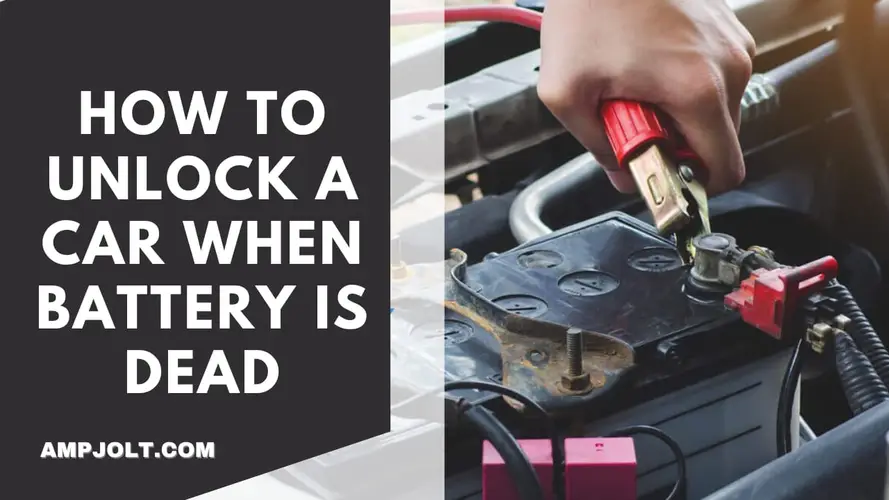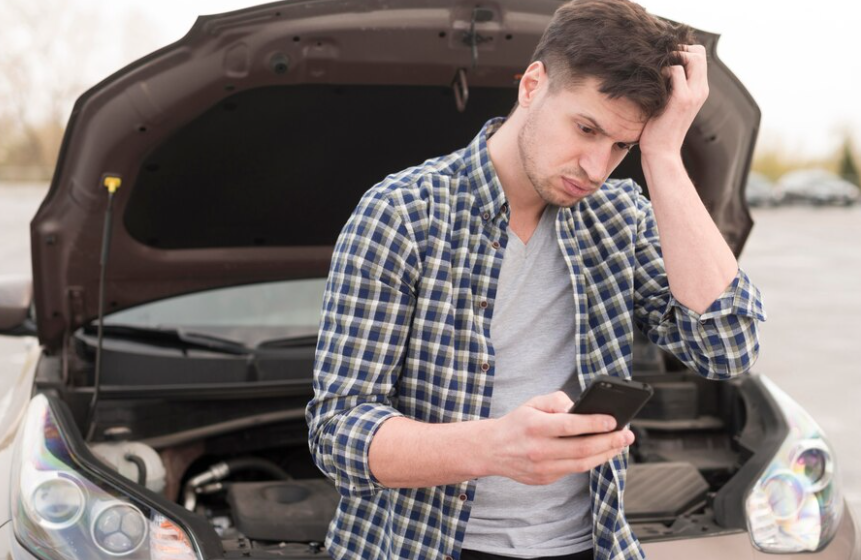Why e bike battery won't charge?
April 14, 2018

Few things are as frustrating as finding yourself locked out of your car, especially when the culprit is a dead battery. However, the situation is not as dire as it may seem.
To unlock a car with a dead battery, use the mechanical key to open the driver's side door manually or locate a hidden key slot for keyless entry. Alternatively, jump-start the car using jumper cables and another vehicle, or utilize a portable jump starter. These methods empower you to regain access despite a dead battery.
In this comprehensive guide, we'll explore various methods and step-by-step procedures on how to unlock a car when the battery is dead, ensuring you have the knowledge and tools to navigate this inconvenient scenario with ease.

Before delving into the unlocking methods, it's crucial to understand the basic functioning of modern keyless entry systems. Most cars today come equipped with electronic key fobs that use batteries to transmit signals to the vehicle. When the key fob battery dies, it can create complications in accessing the car. We'll explore both traditional and keyless entry scenarios.
Scenario 1: Dead Battery, Traditional Key Entry
Scenario 2: Dead Key Fob Battery, Keyless Entry
Scenario 3: Dead Car Battery and Locked Out
Scenario 4: Dead Car Battery, No Other Vehicle Available
Scenario 5: No Access and No Tools
Regularly check and replace the key fob battery to avoid unexpected lockouts.
In some cases, car manufacturers or dealerships can provide specific instructions or assistance remotely.
Some car manufacturers offer mobile apps that allow remote unlocking. Explore this option if available for your vehicle.
Few scenarios are as inconvenient as being locked out of your car, especially when the culprit is a dead key fob battery. To avoid such predicaments, it's essential to adopt preventive measures and integrate practical solutions into your routine.

The simplest yet most effective preventive measure is to routinely check and replace the key fob battery. Most key fobs use coin-cell batteries that are easy to replace. The recommended frequency for battery checks may vary by manufacturer, but conducting this task annually is a good practice. Some key fobs may display a low battery warning on the vehicle dashboard, serving as an additional prompt for replacement.
Establish a battery replacement schedule based on the manufacturer's recommendations. Consider syncing battery replacements with other routine vehicle maintenance tasks to streamline the process. By integrating key fob battery checks into your regular vehicle care routine, you reduce the risk of forgetting this crucial aspect.
Preventive measures extend beyond mere checks; always keep spare key fob batteries on hand. Store these spare batteries in a secure location, such as your home or office, making them easily accessible when needed. Having spare batteries readily available ensures you can promptly address any low battery warnings or unexpected issues.
In addition to spare batteries, consider carrying a spare key. Many vehicles come with a physical key integrated into the key fob. This key can be used to manually unlock the driver's side door or trunk in case the key fob becomes inoperable due to a dead battery. Store this spare key in a secure location, such as your wallet or a key holder, for quick access.
Invest in a key organizer that accommodates spare batteries and other essentials. These organizers often feature compartments designed to hold spare batteries securely, ensuring they don't get lost or damaged. A well-organized key kit can be a lifesaver in preventing lockouts and minimizing disruptions.
Expand your emergency kit to include a portable jump starter. While primarily designed for jump-starting a dead car battery, some models come equipped with USB ports that allow you to charge electronic devices, including key fobs. This versatile tool can provide a quick charge to your key fob, enabling you to unlock your car and address the dead battery issue promptly.
Many car manufacturers offer mobile apps that provide keyless entry capabilities. These apps typically allow you to lock, unlock, and even start your car remotely using your smartphone. Explore whether your vehicle is equipped with such an app and set it up for added convenience.
Always refer to your vehicle's manual for specific recommendations and guidelines regarding key fob battery replacement and maintenance. Manufacturers often provide valuable insights and model-specific instructions to assist owners in maintaining their vehicles effectively.
Finding yourself locked out of your car without a spare key or a portable jump starter can indeed be a challenging situation. However, there are alternative methods and steps you can take to regain access to your vehicle. Here's a guide on what to do if you don't have a spare key or portable jump starter:
If you have access to a roadside assistance service through your insurance or a membership program, it's time to make that call. Roadside assistance professionals are equipped to handle various car-related issues, including unlocking vehicles. They have specialized tools that can open your car door without causing damage
Alternatively, you can contact a professional locksmith. Locksmiths are skilled in handling lockouts and can often reach your location promptly. While their services may come at a cost, it's a reliable and efficient way to regain access to your car.
In some cases, law enforcement officers may assist you in gaining access to your locked vehicle. While this may not be a guaranteed solution, it's worth seeking help if there's a police station nearby. They might have the necessary tools or contacts to assist you in unlocking your car.
Before calling for assistance, take a moment to carefully inspect your vehicle. Check if any windows or doors are partially open. While uncommon, you might be fortunate enough to find a point of entry that doesn't require professional intervention.
If you're in a populated area, consider asking for assistance at nearby businesses or residential areas. Sometimes, someone may have tools or knowledge that can help you unlock your car. Friendly neighbors or local businesses might be willing to lend a hand.
Reach out to your car manufacturer or dealership's customer support. They may have specific recommendations or remote unlocking capabilities, especially if your vehicle is equipped with advanced technology. Be prepared to provide proof of ownership and vehicle details.
If you're in a secure and safe location, and help is on the way, waiting patiently might be the best course of action. Avoid attempting to force open the car door, as this can lead to damage and additional expenses.
If you're stranded in an unfamiliar location and help is taking some time, consider using a ride-share service to get to a more comfortable and secure location. Once you've arranged for assistance or obtained the necessary tools, you can return to your vehicle.
Use this experience as a lesson to prioritize preparation. Once you regain access to your car, consider investing in a spare key and a portable jump starter. Additionally, explore keyless entry mobile apps offered by car manufacturers for future convenience.
While being locked out without a spare key or portable jump starter can be stressful, there are viable solutions available. Whether seeking professional assistance, exploring alternative entry points, or contacting law enforcement, stay calm and take systematic steps to address the situation. Consider this experience as an opportunity to enhance your preparedness for future scenarios.
Encountering a dead car battery and a locked vehicle can be a frustrating experience, but with the right knowledge and tools, you can navigate the situation effectively. Whether using traditional key entry, jump-starting the car, or seeking professional assistance, understanding these methods equips you to handle this inconvenience with confidence. Implement preventive measures, keep emergency tools handy, and embrace the versatility of solutions to ensure a smoother experience when faced with a dead car battery.
If you have a traditional key, locate the mechanical key slot on the driver's side door or trunk. For keyless entry, check for a hidden key slot or use a portable jump starter to power up the car and unlock it.
Yes, if your car has a dead battery and is locked, you can use jumper cables and connect to another vehicle's charged battery. Once your battery gains enough charge, you can unlock the car manually or through keyless entry.
In the absence of another vehicle, consider using a portable jump starter. Keep one in your car as part of your emergency kit to provide the necessary charge to unlock your vehicle.
Yes, routine key fob battery checks, keeping a spare key in a secure location, and including a portable jump starter in your emergency kit are effective preventive measures to avoid getting locked out due to a dead battery.
Some car manufacturers offer mobile apps that allow for remote unlocking. Check if your vehicle is equipped with such an app and explore this option as an alternative method for unlocking your car.
Yes, a dead car battery can affect the key fob's functionality. Ensure your car battery is in good condition to prevent issues with the key fob and subsequent lockouts.
In most modern cars, a dead car battery can affect keyless entry systems. The key fob relies on the battery to transmit signals to unlock the car. If the battery is dead, keyless entry may not work. In such cases, using a physical key or jump-starting the car becomes essential for access.
Yes, a low car battery can affect the functionality of the key fob. The key fob relies on a battery to transmit signals to the car. If the car battery is low, it may impact the key fob's performance, leading to issues such as reduced range, intermittent functionality, or complete failure.
Comments
Write a comment